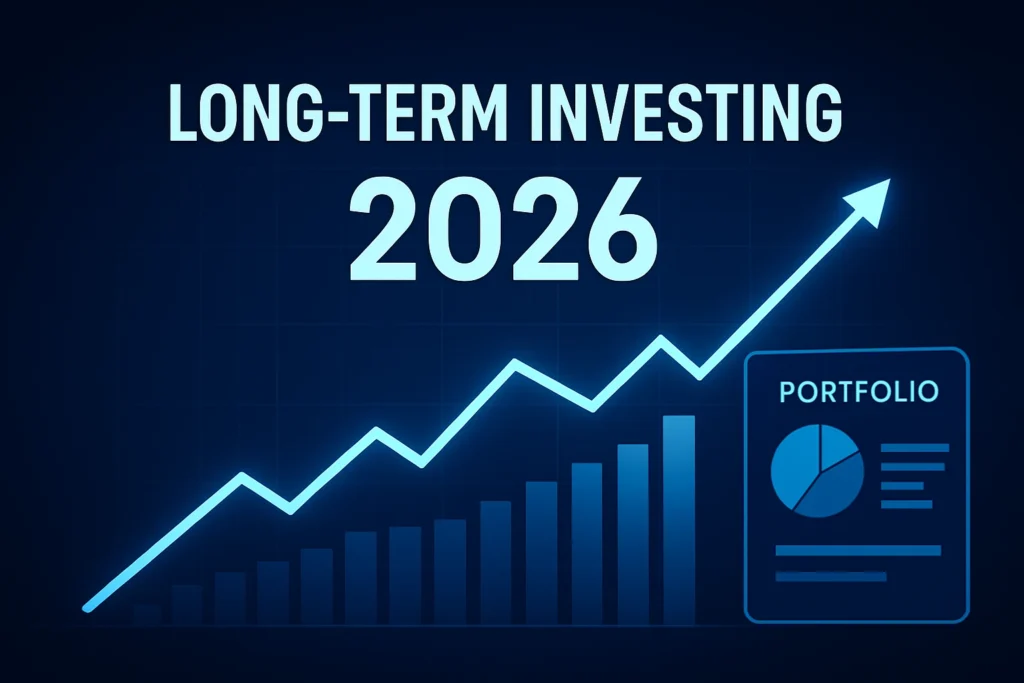Why Long-Term Investing Still Wins in 2026
When you hear the word investing, it’s easy to think of fast profits, meme stocks, or chasing the next crypto boom. But the investors who consistently build wealth and actually keep it know the real secret: long-term investing.
In 2026, the global financial landscape is evolving with new technologies, shifting markets, and emerging opportunities in green energy and artificial intelligence. Yet the core principles of wealth-building haven’t changed. Long-term investing remains one of the most reliable ways to grow money, protect it from inflation, and prepare for retirement or other life goals.
This guide breaks down the basics of long-term investing, practical strategies for beginners, the most effective tools, and the pitfalls to avoid all tailored for today’s financial realities.
What is Long-Term Investing?
Long-term investing means holding onto investments for at least five years, often 10, 20, or even 30 years. Instead of speculating on daily price swings, long-term investors focus on businesses, assets, or funds with proven potential to grow over time.
Benefits of Long-Term Investing
- Compounding power: Your returns generate additional returns over decades.
- Reduced volatility: Short-term dips matter less when your horizon is measured in decades.
- Tax efficiency: Many governments offer tax advantages for retirement and long-term accounts.
- Peace of mind: You’re less stressed about daily market headlines.
For example, someone who invested $10,000 in the S&P 500 in 1990 and left it untouched would have over $160,000 today, despite recessions, market crashes, and crises along the way.
The Core Principles of Long-Term Investing
Successful long-term investing isn’t about luck, it’s about sticking to principles that work.
- Start Early
- The earlier you begin, the more time compounding has to work in your favor. A 25-year-old investing $500/month could retire a millionaire, while someone starting at 40 would need to invest more than double that amount.
- Stay Consistent
- Markets rise and fall, but dollar-cost averaging (investing the same amount regularly) smooths out volatility and avoids the temptation of market timing.
- Diversify
- Don’t put all your eggs in one basket. Spread across stocks, bonds, real estate, and global markets. Diversification reduces risk while still capturing growth.
- Be Patient
- Emotional investing is dangerous. Selling during a crash locks in losses. The best investors stay disciplined, holding through downturns.
Types of Long-Term Investments
Different investors will choose different vehicles depending on their goals and risk tolerance. Here are the most common long-term investment categories in 2026:
Stocks & ETFs
- Individual stocks: High potential, but riskier. Works best when investing in stable, well-managed companies.
- ETFs (Exchange-Traded Funds): Offer instant diversification across industries, countries, or themes.
Bonds & Fixed-Income Assets
- Safer than stocks, but with lower returns.
- Good for conservative investors or as a hedge against volatility.
Index Funds & Mutual Funds
- Passive investing in entire markets.
- Consistently outperform most actively managed funds long term.
Real Estate
- Rental properties or REITs (Real Estate Investment Trusts).
- Generates both income and appreciation.
Retirement Accounts
- 401(k), IRA (U.S.), RRSP/TFSA (Canada), or similar.
- Tax advantages make them essential for long-term plans.
Emerging Opportunities
- Green tech & renewable energy funds
- AI-focused ETFs
- Healthcare innovation funds
Investing in these sectors adds growth potential, but should only complement a balanced portfolio.
Building a Long-Term Portfolio
Step 1: Define Your Goals
- Retirement, buying a home, children’s education, or wealth preservation.
Step 2: Know Your Risk Tolerance
- Conservative: More bonds, fewer stocks.
- Balanced: 60% stocks, 40% bonds.
- Aggressive: 80–90% stocks, small bond allocation.
Step 3: Asset Allocation Examples
- Conservative Portfolio (low risk): 40% bonds, 40% index funds, 20% real estate.
- Balanced Portfolio (moderate risk): 60% stocks/ETFs, 30% bonds, 10% alternative assets.
- Aggressive Portfolio (high growth): 80% stocks, 15% international ETFs, 5% real estate.
Step 4: Rebalance Annually
Rebalancing ensures your portfolio stays aligned with your goals, selling some winners and reinvesting in laggards.
Tools & Platforms for Long-Term Investing in 2026
Technology makes long-term investing more accessible than ever.
- Robo-Advisors: Automate portfolio management (e.g., Betterment, Wealthfront, Questrade).
- Brokerage Apps: Robinhood, Fidelity, Vanguard, Charles Schwab.
- Retirement Tools: Fidelity’s retirement planner, Vanguard calculators, etc.
- AI-driven Advisors: New AI platforms predict allocation strategies and automate rebalancing.
Common Mistakes to Avoid
Even with the best intentions, many investors fall into traps.
- Panic Selling: The market always recovers in the long run.
- Chasing Hot Trends: Jumping into hype stocks too late often leads to losses.
- Overlooking Fees: High management fees eat into returns.
- Neglecting Taxes: Tax planning is as important as investing itself.
- Not Diversifying: Relying on one stock, sector, or region increases risk.
Long-Term Investing in 2026
Looking ahead, several macro-trends will shape how investors succeed:
- Sustainable Investing (ESG): Environmental, Social, and Governance funds are becoming mainstream.
- AI-Driven Investing: Algorithms can optimize portfolios faster than human managers.
- Global Diversification: Emerging markets in Asia, Africa, and Latin America provide growth opportunities.
- Retirement Crisis Awareness: Governments are encouraging long-term investing through incentives.
Conclusion
The truth is simple: investing is not about timing the market; it’s about time in the market.
By starting early, staying consistent, diversifying, and resisting emotional decisions, anyone can build wealth over decades. 2026 offers new tools, opportunities, and platforms but the timeless principles remain unchanged.
Whether you’re saving for retirement, your child’s future, or financial freedom, long-term investing is still the most reliable strategy. Start today your future self will thank you.

